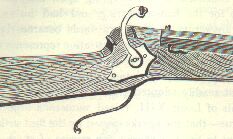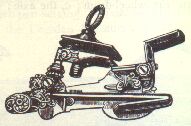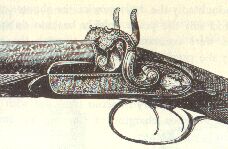The Chinese are credited with the invention of gunpowder, a simple mixture of sulfur, charcoal and saltpeter. However, its use was mainly limited to fireworks displays and fire-throwing weapons; even after its introduction to Europe in the 14th century. Once the effectiveness of gunpowder-driven projectiles against a knight's armor or stone fortifications was realized, true firearms development began.
The first source of development was in the firing mechanism. Some way was needed of igniting the black powder, and touching a flame to the powder while simultaneously trying to aim the weapon was cumbersome. Matchlocks used a burning wick held in a metal arm, which rotated to touch the powder when a trigger was pulled. But what did you do if your wick went out? Better solutions in the 18th century were the flintlock, which snapped a piece of flint against steel to shower sparks onto the powder charge; and the wheellock, which spun a wheel against the steel plate to produce sparks.
 |
 |
| Matchlock (left) and flintlock rifle actions. | |
By the 19th century, advances in explosive chemistry meant you could place a small bit of friction-sensative chemical into a cap. When this was struck by a metal arm, or hammer, it ignited; sending flame into the powder charge... the first primers were born. However, weapons were still loaded from the muzzle; the powder charge and then the bullet had to be rammed down the barrel. In the mid-19th century, inventors combined the cap or primer, powder charge, and bullet into one brass cartridge- gone were problems with wet powder or inconstant powder charges. Another advantage was that rounds could be loaded through the breech end of the gun, significantly speeding up the reloading process. Inventors now sought new ways to get the rounds into the chamber- either by rotating them into place with revolvers, camming them with bolt-action and lever-action rifles, or through intricate semi- and fully-automatic feeding designs. Further refinements in the powder took place- moving from the simple black powder formula to "smokeless powder", using nitrocellulose mixtures to improve power and reduce the residue left behind- as well as improvements in accuracy and reliability.
 |
| Percussion lock rifle action. |
What does the future hold for firearms? For projectile weapons as we know them, research is currently underway in caseless ammunition and electrically-fired weapons. Beyond that, only time and imagination will tell.